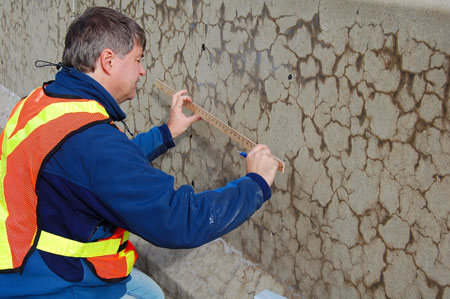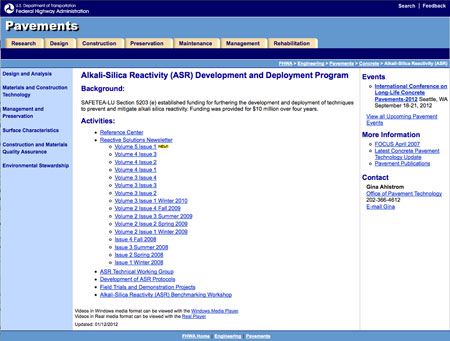U.S. Department of Transportation
Federal Highway Administration
1200 New Jersey Avenue, SE
Washington, DC 20590
202-366-4000
Focus
| Accelerating Infrastructure Innovations |
Publication Number: FHWA-HRT-12-010
Date: January/February 2012
Printable Version (.pdf, 0.8 mb)
Find the most current information on alkali-silica reactivity (ASR) at the Federal Highway Administration's (FHWA) online ASR Reference Center (www.fhwa.dot.gov/pavement/concrete/asr.cfm). Launched under FHWA's ASR Development and Deployment Program in 2009, the recently updated center contains more than 300 specifications, guidance documents, test methods, and other references on ASR.
"The center is designed to provide highway engineers and other practitioners with resources and information on ASR that are readily accessible," said Gina Ahlstrom of FHWA.
ASR occurs when silica in some aggregates and alkalis in concrete combine with water to form a gel-like substance. As the gel absorbs water and expands, it can cause the concrete to crack. Over time, the cracks enable other forms of distress to occur, such as freeze-thaw damage or corrosion. This can lead to premature deterioration and loss of service life for concrete pavements and structures. FHWA's ASR Development and Deployment Program focuses on providing information about ASR and implementing technologies that can prevent and mitigate the problem.
Designed for quick and easy access, the Reference Center features an introductory overview of ASR, as well as research reports, State specifications, and guidance documents. Also featured on the site are case studies from around the world, including field trial summaries that document ASR treatment methods and test results. Visitors can also find specifications and guidance from international agencies, such as the Canadian Standards Association and the International Union of Laboratories and Experts in Construction Materials, Systems, and Structures.
Two new documents being developed by FHWA, Alkali-Silica Reactivity Field Identification Handbook and Alkali-Silica Reactivity Surveying and Tracking Guidelines, will be available by this summer.
To contribute information to the ASR Reference Center or suggest resources to be added, contact Jesse Kwilosz at The Transtec Group, Jesse@TheTranstecGroup.com.
Updates on ASR can be found in FHWA's free quarterly technical update, Reactive Solutions. The update is available at www.fhwa.dot.gov/pavement/concrete/reactive/index.cfm. To subscribe, send an email to asrnewsletter@transtec.us.
For more information on the ASR Development and Deployment Program, contact Gina Ahlstrom at FHWA, 202-366-4612 (email: gina.ahlstrom@dot.gov), or visit www.fhwa.dot.gov/pavement/concrete/asr.cfm.


A highway worker uses a ruler to examine a concrete median barrier affected by alkali-silica reactivity (ASR). To learn more about ASR, visit www.fhwa.dot.gov/pavement/concrete/asr.cfm.